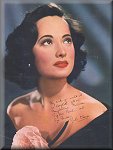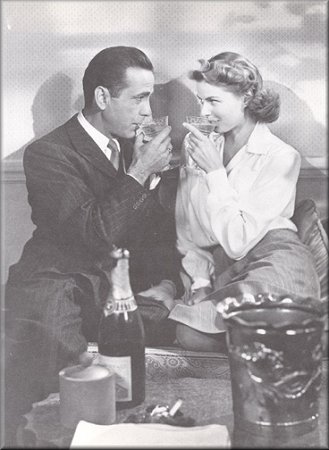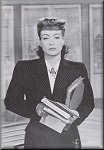|
|
|
Introduction
The images collected here
on these pages are geared toward evening and performance wear. Please use
this site as a resource to help you familiarize yourself with the look
and feel of the Swing Era and to get In the Mood for our Big Band concert
in June!
 |
Ladies'
Fashions
Ladies' fashions in the 1940s reflected a country at war. The 1940s silhouette was tailored and strong, broad-shouldered and slim-hipped, practical and down-to-earth. Shoulders were heavily padded. Skirts were worn just below the knee and slightly flared. Gored or pleated skirts, fitted bodices, shirtdresses that buttoned down the front, and tailored dinner suits were popular. For evening, short cocktail dresses were worn more often than long. Necklines were more demure than in the 1930s, but the plunging sweetheart neckline was very popular. A simple little black dress that could be accessorized a number of ways was an important staple of any woman's wardrobe. Outfits in red, white and navy blue were popular and patriotic. Wool was needed to make uniforms, so many dresses were made of rayon and rayon blends instead. |
| Hollywood
Fashions
Hollywood fashion exaggerated everyday fashion. Costumes in the 1940s were still lavish despite shortages of materials--morale had to be kept up, after all. Some of the displaced Paris designers found homes in Hollywood. Bombshells like Rita Hayworth, Dorothy Lamour and Betty Grable were the favorite pin-ups of boys at war. Cool beauties like Lauren Bacall, Ava Gardner and Gene Tierney offered an alternative as sultry femme fatales. Check out the eye-candy in this gallery and let your imagination take flight. |
 |
 |
Shoes
and Stockings
Leather was scarce during the war, and shoes were rationed. Shoes had a chunky, foreshortened look. They were worn low with a cuban heel, or with three-inch heels for dress. Open toes and ankle straps were popular, as well as platforms and decorative bows. Shoes generally came in black and brown, and white for summer. Many costumers use seamed stockings when costuming a war period piece. During World War II, some people wore them and some didn't. Nylon hose first became available in 1940. Although nylon was not available during the war (it was diverted for the manufacture of parachutes), seamless hose were available. They were usually made of twisted rayon or rayon/cotton blends. Women also used leg make-up instead of stockings, sometimes using an eye-brow pencil to draw a seam up the back to lend authenticity. What a pain! Don't feel under any pressure to wear seams. By the way, nylon hose became available again in 1945. |
| Hats
and Hairstyles
During the war, women sometimes wore their hair in elaborate feminine styles, with masses of curls or rolls on top. Some women wore short curly bobs, but most wore their hair longer, in a flowing shoulder-length bob, softly waved or loosely curled. Hair might be swept up into a soft pompadour, or turned under into a neat pageboy. Bangs were often worn, either curled or waved. Hair was often held in place by a ribbon or combs, or tucked into a snood. For evening, a jeweled clip or flowers might dress a lady's hair. This gallery contains some hair images, but be sure to note all the hairstyles in all the photos throughout the site. Although women were wearing hats less than they did in the 1930s, they were still wildly popular and came in a wide variety of styles. Wide brims were popular for daywear, and different variations on the beret were hot. Hats were not worn often in the evening. If they were, they were small and ornate and frivolous, often adorned with sequins, rhinestones or plumage. They were worn cocked at outrageous angles and often sported veils. For our purposes, I would caution against wearing a hat that might draw attention to itself and away from your performance. |
 |
 |
Cosmetics
Women's make-up in the 1940s generally consisted of a pan-cake foundation, brows strongly defined with eye-brow pencil, mascara, and bright red lipstick and nail polish. A little rouge was sometimes worn to give a more natural effect to pan-cake make-up. Eye shadow was practically unheard of outside of Hollywood. |
| Accessories
Swing Era accessories were often gay and colorful to liven up otherwise conservative, basic outfits. Gloves, handbags and belts were made to coordinate in vibrant colors. Gloves were not necessary with evening wear, but were sometimes worn. Shoulder bags were popular, as well as pouch-style bags and clutches for evening. Frilly or lacy collars, detachable peplums, or bejeweled belts transformed the basic dress into different looks for evening. |
 |
 |
Jewelry
Costume jewelry in the 1940s was fanciful, and was often made with rhinestones or imitation gems of glass or plastic. Swing gals wore necklaces, earrings, brooches, hat pins, hair ornaments, and bracelets--link style or bangles. Pairs of jeweled clips were used to ornament a neckline or dress up a pair of shoes. Of course, pearls were the old stand-by, always elegant with that little black dress. |
| Men's
Fashions
Most men were in uniform, but when they weren't they were sporting the same big shoulders that the ladies were. Men's suits were often glen plaid or pinstriped, and jackets were worn loose and boxy--usually double-breasted with peaked lapels. Ties were fairly wide, with loud prints, and they sometimes matched a pocket handkerchief. Trousers were full, but made without pleats and cuffs during the war, to save on material. There was less formal dress during the war as well, but for semi-formal occasions a white dinner jacket with a shawl collar could be worn with black trousers and a black bow tie. Plain black oxfords or slip-on shoes with black socks completed the outfit. Men generally wore fedora style hats on the street, but took them off indoors. Men wore their hair short in the 1940s, parted on the side or combed back. They were clean shaven, but occasionally sported a small, neat moustache. |
 |
 |
Hit
Parade
Go on tour with the hottest bands of the Swing Era. Come on hep-cats, enter this gallery and jive with your favorite Big Bands: Glenn Miller, Harry James, Tommy Dorsey... These big band shots should put you In a Sentimental Mood or make you want to go Stompin' at the Savoy. |
| In
the Mood
Here are some some pictures just for fun, to put you In the Mood. The pictures in this gallery are a mixed bag of favorite images from the 1940s, mostly from the cinema. Some of them might even give you fashion ideas. Enjoy! |
 |
 |
Resources
A collection of links to related fashion and music web sites, a bibliography and acknowledgements, plus a few other cool tools. Check it out! |
|